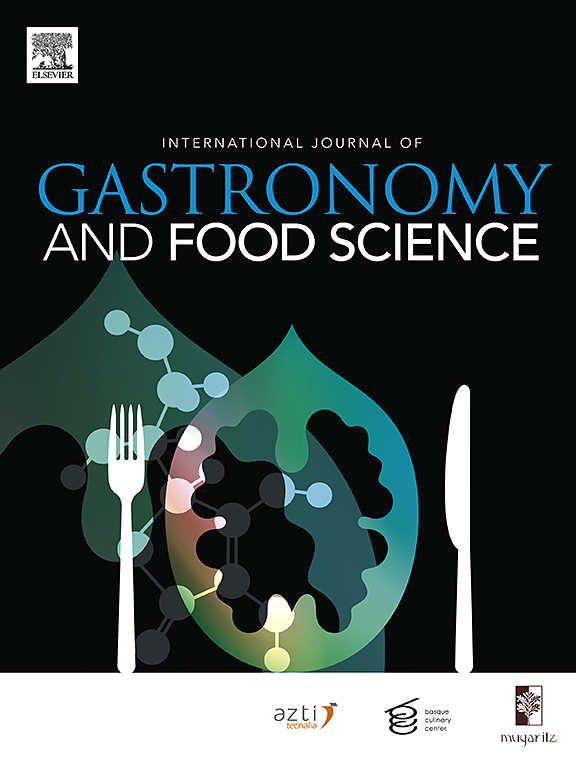Hybrid meat products: Effects of different pretreated bean flours and levels on the physicochemical and techno-functional characteristics of sausages
IF 3.6
2区 农林科学
Q2 FOOD SCIENCE & TECHNOLOGY
International Journal of Gastronomy and Food Science
Pub Date : 2025-07-01
DOI:10.1016/j.ijgfs.2025.101239
引用次数: 0
Abstract
Hybrid meat products are gaining popularity as consumers seek to reduce meat intake. This study evaluates the impact of substituting meat with raw (R-), soaked (S-), and soaked & cooked (SC-) bean flour (BF) at two levels (8 and 15 g/100 g) on the batter properties and the physicochemical, techno-functional, textural, and microstructural qualities of sausages. Higher flour levels increased batter firmness, cohesiveness, and consistency, leading to sausages with greater hardness and adhesiveness. R-BF sausages exhibited the highest yields, water-holding capacities, flavonoid contents, and antioxidant activities. SC-BF formulations had lower cohesiveness and trypsin inhibitor levels, producing sausages with a more open, rough structure, likely due to the pregelatinized starch. These structural changes correlated with lower chewiness and springiness.
These findings indicate that bean flours, have the potential as techno-functional ingredients in hybrid sausages, offering a viable option for consumers in search of reducing their meat intake while maintaining desirable physicochemical properties and enhancing nutritional benefits.

杂交肉制品:不同预处理豆粉和水平对香肠理化和技术功能特性的影响
随着消费者寻求减少肉类摄入量,混合肉制品越来越受欢迎。本研究评估了用生肉(R-)、浸泡肉(S-)和浸泡肉(p -)替代肉类的影响。煮熟的(SC-)豆粉(BF)在两个水平(8和15克/100克)对面糊特性和香肠的物理化学、技术功能、质地和微观结构品质的影响。更高的面粉含量增加了面糊的硬度、粘性和稠度,从而使香肠具有更大的硬度和粘性。R-BF香肠表现出最高的产量、保水能力、类黄酮含量和抗氧化活性。SC-BF配方具有较低的粘性和胰蛋白酶抑制剂水平,生产的香肠具有更开放,粗糙的结构,可能是由于预糊化淀粉。这些结构变化与较低的咀嚼性和弹性有关。这些发现表明,豆粉有潜力成为杂交香肠的技术功能成分,为寻求减少肉类摄入量,同时保持理想的物理化学特性和提高营养价值的消费者提供了一个可行的选择。
本文章由计算机程序翻译,如有差异,请以英文原文为准。
求助全文
约1分钟内获得全文
求助全文
来源期刊

International Journal of Gastronomy and Food Science
Social Sciences-Cultural Studies
CiteScore
5.30
自引率
10.50%
发文量
170
审稿时长
45 days
期刊介绍:
International Journal of Gastronomy and Food Science is a peer-reviewed journal that explicitly focuses on the interface of food science and gastronomy. Articles focusing only on food science will not be considered. This journal equally encourages both scientists and chefs to publish original scientific papers, review articles and original culinary works. We seek articles with clear evidence of this interaction. From a scientific perspective, this publication aims to become the home for research from the whole community of food science and gastronomy.
IJGFS explores all aspects related to the growing field of the interaction of gastronomy and food science, in areas such as food chemistry, food technology and culinary techniques, food microbiology, genetics, sensory science, neuroscience, psychology, culinary concepts, culinary trends, and gastronomic experience (all the elements that contribute to the appreciation and enjoyment of the meal. Also relevant is research on science-based educational programs in gastronomy, anthropology, gastronomic history and food sociology. All these areas of knowledge are crucial to gastronomy, as they contribute to a better understanding of this broad term and its practical implications for science and society.
 求助内容:
求助内容: 应助结果提醒方式:
应助结果提醒方式:


